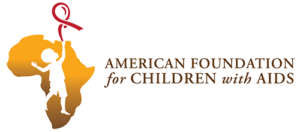Start of Day 5.
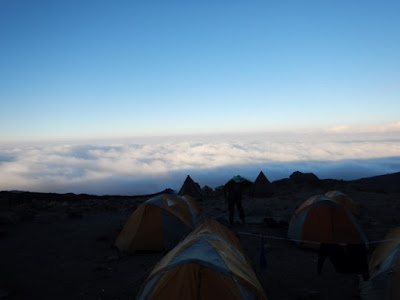
Morning at Karanga Camp, 13,100′.
At this point, every morning felt a bit the same. Drink a perfect cup of coffee from John, crawl into some clothes, some or all of which may be clean if I was lucky. We would often announce things like, “Hey everyone, I have clean socks/pants/shirt/bra!” if it was such a day. Fiddle with my blister, which although hadn’t improved after four days of hiking, also hadn’t worsened. Stumble out of the tent, gasp and the view, fight with hair, enjoy the hot bowl of water outside my tent to wash with, then roll in to the dining tent with empty camelback and water bottles for breakfast.
I don’t mean to make the mornings sound bad, or dull, or mundane, but they were a bit routine. To me, there’s always something nice about routine. It’s calming, knowing what to expect, or what is expected of you. Granted, this particular set of mornings, one would call anything but “routine”, but there was a bit of it stuck in there.
Nothing from the morning at Karanga sticks out in my memory, other than a bit of anxiousness. Describing it is hard. This was the day we were to hike to Barafu, and Barafu is the camp from which we would summit. So, in leaving Karanga, I had this broad, vague, distant bit of nervousness. Summit night (more on the ‘night’ part later) was rapidly approaching. I wasn’t feeling 100%, as I’d had a cold for a few days. Oh yeah, I forgot to mention. I had been fending off a head cold since the first day in Tanzania. I was pretending it didn’t exist, that it was all in my head. I wasn’t making a big deal out of it, hoping it would fade. Things were going fine, but I knew I wasn’t as strong as I could be.
This day would be a short hike, maybe 3 or 4 miles if I recall correctly. We were to be at Barafu for lunch, then had been instructed that we were to nap in the afternoon. So, off we went, carrying as much water as we could since there was no water supply at Barafu. Up we went.

Trail leaving Karanga, porter, Kili.
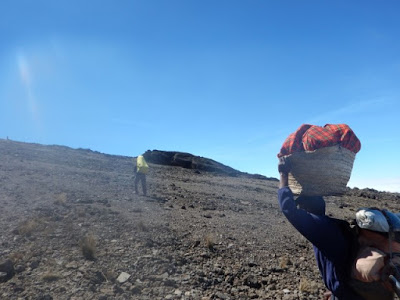
Endless hill
The hill outside of Karanga seemed to go on and on. Seemingly headed straight into the sun, we continued to follow each other, putting one foot in front of the other. We had started at 13,100 feet, so conversation was not as boisterous as some previous days, and at times I felt like we were all focused on the task at hand. The silence wasn’t at all awkward or uncomfortable, as silences sometimes can be. At one point, I paused and turned around and was surprised at what I saw.
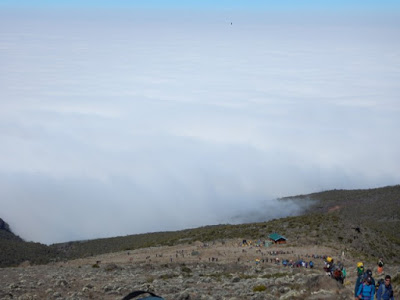
String of hikers leaving Karanga.
Behind us was a string of hikers and porters. Keep in mind, we were usually one of the last few groups to leave a camp, so most of the people were actually ahead of us, and there were STILL this many people behind us. It reminded me again of just how many people are on this mountain at any given time.
One foot, one foot, one foot, sip of water. Up we went, heading to 15,300 feet. We took all the regular tire pressure and snack breaks, even stopped a few times just to enjoy the view. Kilimanjaro was right there. Instead of being way down by her feet, we were on her shoulders now. Seeing the top this close was another reminder that summit night was TONIGHT.
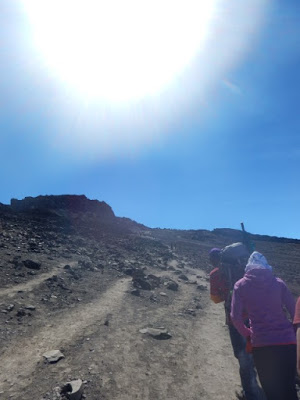
Everyone was focused.
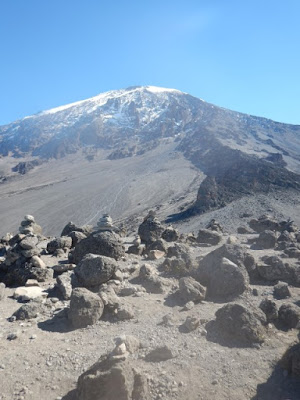
Kili, she’s close now!
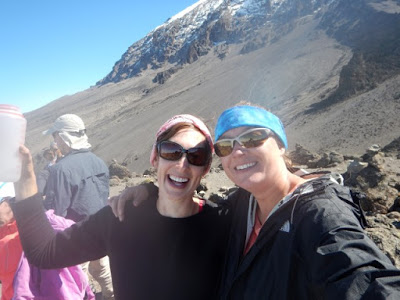
Water break!
I think it was here, at this water break, where we could see Barafu Camp. A short day felt good, so I was excited that we could see camp. The thought of an afternoon of rest was pretty appealing!
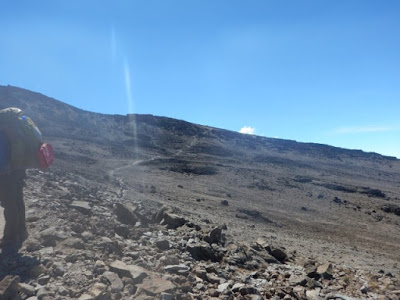
Barafu in sight!
It’s hard to see in this picture, but Barafu is on the top of that ridge, just left (uphill) of where the trail reaches the top of the ridge. Great! We just had to walk across that plain, then up another steep hill. Again, a bit of anxiousness crept in to my mind. That’s camp. That’s the camp where I will summit from. As we crossed that plain, moods were cheery and the walking was easy. Just before the ridge, we noticed that people had cleared rocks (boulders?) from areas, then used those rocks to spell words. “hello” or “jambo” or “Julie” or “Dan”…all sorts of things were spelled out. I kept thinking how amazing that people would take (and have!) the energy to lift heavy rocks and move them around.
We got to the base of the ridge, probably took a break, then headed up. The trail up that ridge was pretty straight up, not a lot of switchbacks. And we didn’t stop…once. We were like the little engine that could, slowly plodding up that trail, almost as if any loss of momentum would stop us forever. Our guides took us right up to camp.
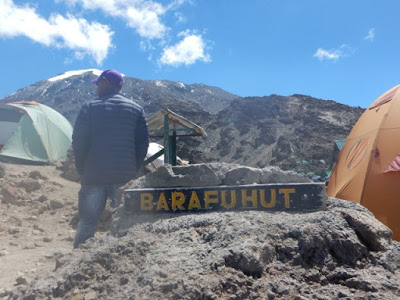
Barafu Hut, 15,300′
Now normally, camp felt welcoming. Tents felt friendly, and were set up in some sense of “community”, in a circle, or next to each other, something that felt communal. Not at Barafu. Barafu felt harsh and alien, uninviting and exposed. One of my first thoughts was, “we’re camping HERE? This is the best spot around to camp?”
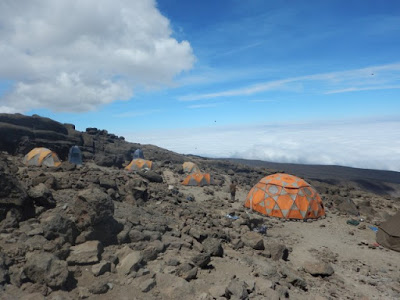
Our camp at Barafu
The site was a volcanic boulder field, on a slope, and it was windy. Part of me felt like something was going to happen to make it better. Maybe the wind would stop. Maybe my tent would magically be on the ONLY flat rectangle of ground in the area. Maybe the rocks under my thermarest would actually feel like little massaging hands. Alas, nope. This was our site. This was to be our haven before and after summiting Africa’s highest peak. This was to be our energizing site and our recovery site. You have GOT to be kidding me.

Looking out from our site
Which tent looks the most comfy? Ours was the one just on the other side of the person in the gray coat in the center of the picture above. Front and center, facing the wind. Oh boy.

Tents tucked in where they would fit

But hey, clean toilet!!!
Time for a comedic break, as I feel this particular post has been pretty serious. I don’t mean it to be, and I don’t think this day was any more serious or any “worse” than previous days overall, but personally I felt, again, a bit of anxiousness. Ok, comedy.
So, the toilets. Yay for clean toilets! We rolled into camp, went and registered, then had time to settle in before lunch. I had to go, a “long call” if you recall the terminology from “Kilimanjaro Part 3: Machame Gate to Machame”. If you don’t recall, feel free to refer back to that entry. As I approached one of our two toilets, I could tell someone was in there by the feet sticking out a bit. So I waited. Soon, the occupant came out, and quickly said, “Oh, I’m sorry!” and went off to unpack. When I entered, I noticed that they had had a long call as well. But really, at this point, it was no big deal. So I did my business, and noticed with a chuckle, that mine looked just like theirs! Clearly, we had been eating all the same things. Later, I saw that person and commented, “hey, no worries, clearly we’re on the same diet!” and all feelings of awkwardness vanished. So yay for toilets!
I looked around, and looked up. Tents trickled up the ridge, then a faint trail could be seen winding up. “That’s it, that’s my trail”, I thought. The part I could see didn’t look so bad. But it was daylight, and I couldn’t see much. When we had registered, we met a few men coming down and they made some snide comment, something along the lines of, “Good luck, you’ll need it”. This, among other things, continued to play in my mind.
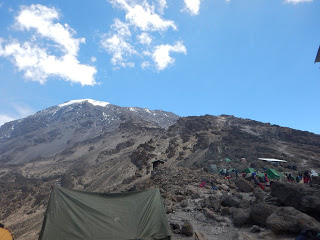
Once we were all settled, we had lunch. Felix had a lot to tell us. After lunch we were to sleep or rest in our tents until dinner. During this time we were also to collect exactly the clothes/gear we were going to use for summiting, and he could come and check it all before dinner. Around 5, we would have dinner, go over safety gear, then we were to sleep again. We would be awakened at 11pm, have a light meal, then leave at midnight to summit. Fun, right? Let’s do this.
Also much to my relief, Felix said the coldest we could expect would be around 15 degrees F. Heck, that’s not bad! When we heard this, Donnie and I had high-fived. We’re from Colorado, we’re tough!
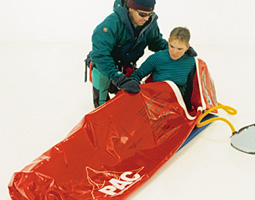
I don’t remember dinner, but I do remember discussing the safety gear. I wish I had a picture of some of it, so I borrowed the above from the internet. One summit porter was to carry first aid kits and oxygen in case we needed it. Another carried a PAC bag (Portable Altitude Chamber). This was in case someone was beyond the point where oxygen would help. They’d be placed in this body-sized bag, which can be filled air/oxygen to simulate air pressure above ambient. It basically simulates lower altitude air pressure/environment, allowing the crew to carry the person down. Felix assured us that they had never used it, but always took it in case. It felt good to learn all of this, and it made me feel safe. Summiting a 19,300 peak in the dark would not be easy, and there certainly would be chances for trouble.
Felix instructed us what to put in our packs, and how to pack. Water bottles were to be slid into dirty (or clean, but hey, nobody had clean anything) wool socks to insulate them. They were to be put INSIDE the packs, top down, so if they freeze you could still drink. We were to carry as much water as possible, since it was unknown how long we would be on the mountain. Snacks were to be maximized as well. Spare batteries for headlamps and cameras were to be kept as close to our bodies as possible. It all felt so detailed and specific, I felt stressed again. What if my water froze, or my camelback cracked? What if my headlamp broke? What if my blister FINALLY decided to rupture? Beyond the more gear-oriented worries, of course I was worried about making it. What if my O2 level at 11:00 was too low? What if I didn’t make it up? What if I came all this way, hiked for 5 days, then didn’t make it? How would I handle that, how would I tell people, and what would they think? What if my cold prevented me from summiting? Could it? Would it? There were so many thoughts and worries in my brain as we left the safety meeting….and I couldn’t make them go away.
We all crawled into our tents, hoping to sleep. At 11:00, someone would wake us up, we’d get dressed, pack our backpacks, and head up to 19,341 feet. In the dark.
Blog post by: The Heskin Family
